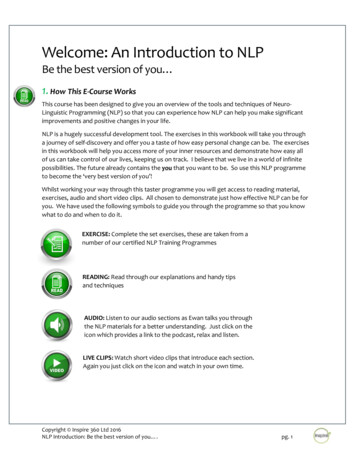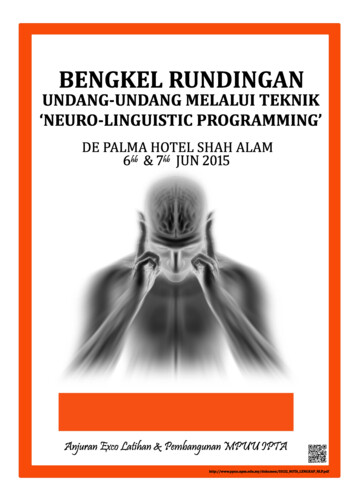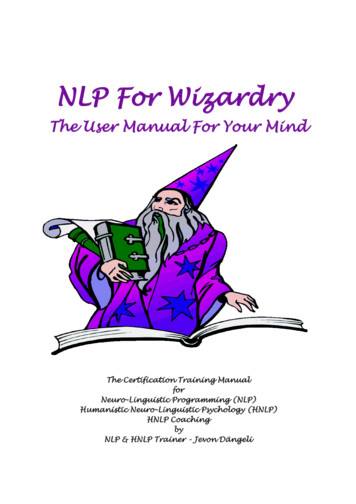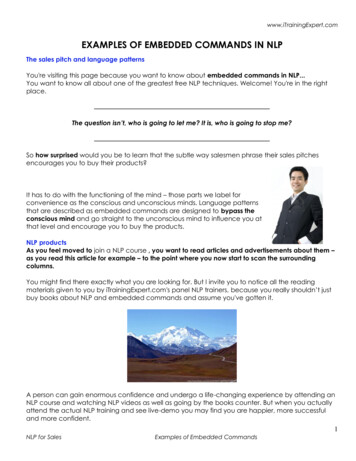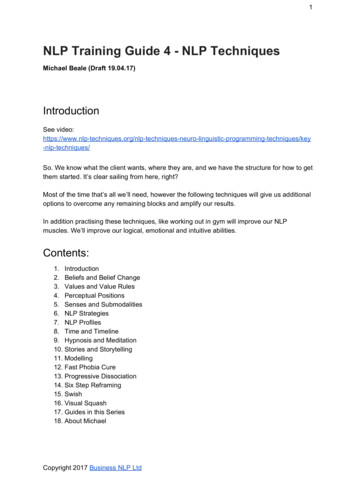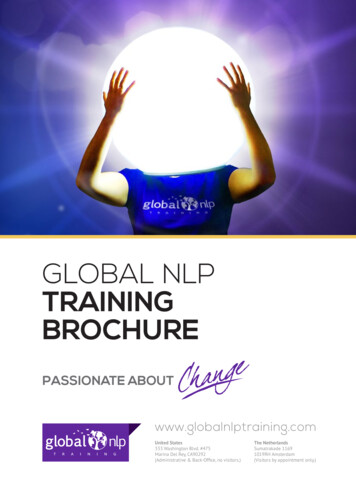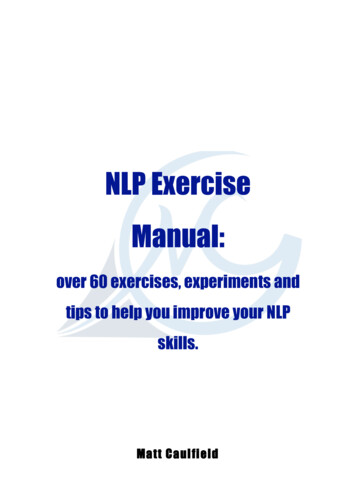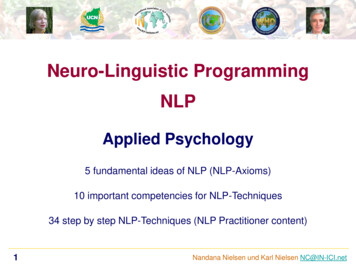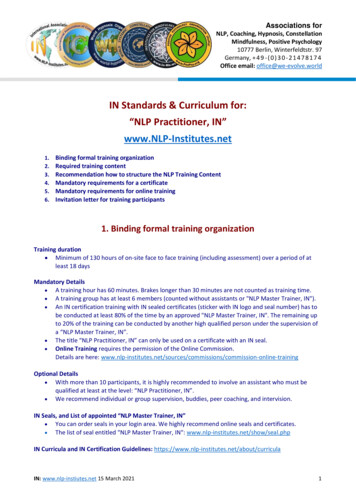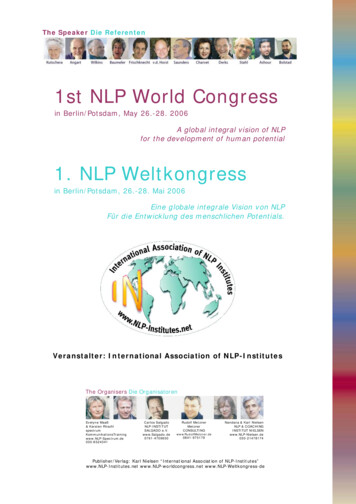
Transcription
The Speaker Die Referenten1st NLP World Congressin Berlin/Potsdam, May 26.-28. 2006A global integral vision of NLPfor the development of human potential1. NLP Weltkongressin Berlin/Potsdam, 26.-28. Mai 2006Eine globale integrale Vision von NLPFür die Entwicklung des menschlichen Potentials.Veranstalter: International Association of NLP-InstitutesThe Organisers Die OrganisatorenEvelyne Maaß& Karsten rum.de030-8524341C arlos SalgadoNLP-INSTIT UTSALGADO e.V.www.Salgado. de0761-4709650Rudolf MetznerMetznerC ONSULTINGwww.Rud olfMetzner.de0841-975179Nandana & Karl NielsenNLP & C OAC HINGINSTITUT lag: Karl Nielsen “Internat ional Associat ion of NLP-Institutes”www.NLP-Institutes.net www.NLP-worldcongress.net www.NLP-Weltkongress-de
International Association of NLP-Institutes (IN)Der IN-VorstandKarl NielsenIN-PräsidentEvelyne MaassIN-Vize-PräsidentinBernd IsertIN-DirektorWolfgang LenkIN-DirektorTerms of admission of the INThrough their signature on the membership contract, every IN member pledges to activelyuphold the following ethics and quality principles:1. I support the good reputation of the IN and of NLP, and abide to the ethics and qualityguidelines of the IN.2. I only recommend and partake in such certified NLP trainings, that comply with the quality standards of the IN.3. In dealing with trainees, colleagues and competitors I’m always fair and cooperative.4. I apply myself for the IN, will act as an IN contact for those who seek information aboutthe IN and keep my personal information on the IN website updated.5. I assume the obligation to advertise NLP in its highest quality, in my own manner andwith the means available to me and support networks and quality circles in the IN.On the basis of these rules, we expressly invite every qualified follower of NLP to be part ofthe IN. More see under:www.nlp-institutes.net/membe rship.htmAufnahmebedingungen der INIm Aufnahmeantrag verpflichtet sich jedes IN-Mitglied zur aktiven Einhaltung folgender Ethik- und Qualitätsgrundsätze:1. Ich unterstütze aktiv den guten Ruf der IN und des NLP und halte mich an die Ethik- undQualitätsrichtlinien der IN.2. Ich empfehle und beteilige mich nur an solchen zertifizierten NLP-Ausbildungen, die mitden Qualitätsstandards der IN vereinbar sind.3. Mein Verhalten im Umgang mit Seminarteilnehmern, Kollegen und Mitbewerbern ist fairund kooperativ.4. Ich setze mich für die IN ein, bin auch Ansprechpartner der IN für andere, die sich überdie IN informieren möchten und halte meine Daten auf der IN-Webseite aktuell.5. Ich verpflichte mich, mit meinen Mitteln und in meiner Art, NLP in hoher Qualität bekanntzu machen und unterstütze Netzwerke und Qualitätszirkel in der IN.Wir laden jeden qualifizierten NLPler dazu ein, auf dieser Grundlage bei uns Mitglied zu werden. Mehr siehe unter:www.nlp-institutes.net/mitglied schaft.ht m2International Association of NLP-Institutes (IN)
Congress design / KongressgestaltungThis congress is the result of the vision of Evelyn Maass and Karsten Ritschl of spectrumKommunikationsTraining and Nandana & Karl Nielsen of NLP & Coaching Institut Berlin. Theirdecidedness, enthusiasm and persistence for making a contribution to the NLP Community in the senseof a visible world-wide quality is it to be owed that there is this congress and we can share it with oneanother.Evelyne MaaßKarsten RitschlNandana NielsenKarl nikationsTrainingNLP & CoachingInstitut BerlinNLP & CoachingInstitut P-Nielsen.dewww.NLP-Nielsen.deDieser Kongress ist das Ergebnis der Vision von Evelyn Maass und Karsten Ritschl vom spectrum KommunikationsTraining und Nandana & Karl Nielsen vom NLP & Coaching Institut Berlin. Ihre Entschiedenheit, Begeisterung und Beharrlichkeit, einen Beitrag zur NLP Community im Sinne einer sichtbarenweltweiten Qualität zu leisten, ist es zu verdanken, dass es diesen Kongress gibt und wir ihn miteinander teilen können.The financial and organisationalresponsibility was beard too byDie finanzielle und organisatorischeVerantwortung haben auch mitgetragenRudolf MetznerCarlos SalgadoMetzner ConsultingNLP-Institut Salgado e.V.www.rudolfmetzner.dewww.salgado.deEngaged inInspirations andCo-OrganisationProf. Dr.Cordula Ehms & Ray WilkinsBarbara Schott College for Coaching, Training, Artmindbalance e.V.www.mindbalance.deand Complementary MedicineBeteiligt anInspirationen undCo-Organisationwww.ehmswilkins.comCarolaKarin Pätzevon Garnier Karin PätzeInstituto Avance Consultingwww.instituto- www.KarinPaetavance.com zeConsulting.deEngaged in the Inspirations are besides the above mentionedAn den Inspirationen beteiligt sind neben den oben genanntenThe Speaker / Die Referentenwww.NLP-Worldcongress.net3
DedicationThis 1st NLP World Congress, as well as this book, are dedicated to all those, whomeet the professional standards of an ethically founded NLP training of the highestquality.We owe thanks to Leslie Lebeau, Judith DeLozier, Richard Bandler, John Grinder andRobert Dilts for developing NLP in the early seventies.Furthermore we also dedicate this book to all those who have helped to evolve NLPsince its beginnings, especially to the members of the "International Association ofNLP Institutes" (IN) at all NLP and coaching levels, currently applying our high ethicsand quality guidelines across the globe, teaching and living it at its highest possiblelevel.WidmungDieser 1. NLP-Weltkongress und dieses Buch dazu ist all denen gewidmet, die denprofessionellen Standard ethisch fundierter und qualitativ hochwertiger NLP-Ausbildungen erfüllen.Wir danken Leslie Lebeau, Judith DeLozier, Richard Bandler, John Grinder und RobertDilts, dass sie NLP Anfang der 70er Jahre entwickelt haben.Wir widmen dieses Buch auch allen, die NLP seither weiterentwickelt haben und aufeinem hohen Standard lehren und leben, ganz besonders den Mitgliedern der International Association of NLP Institutes (IN) auf allen NLP- und Coach-Ausbildungsstufen, die unsere hohen Ethik- und Qualitätsrichtlinien überall auf der Welt anwenden.Grafik: Robin Bangel4International Association of NLP-Institutes (IN)
International Association of NLP-Institutes (IN)1st NLPWorld CongressA global integral Vision of NLPfor the development of human potential1. NLP WeltkongressEine globale integrale Vision von NLPFür die Entwicklung des menschlichen Potentials26.-28. May/Mai 2006 in Berlin, GermanyRedaktionell verantwortlich: Karl Nielsen, InternationalAssociation of NLP-Institutes, Germany, Berlin, Mai 2006www.NLP-Worldcongress.net5
Index of contents / InhaltsverzeichnisPage/SeiteKarl Nielsen: Introduction . 8Karl Nielsen: Einleitung . 13Evelyne Maass & Karsten Ritschl: Congress Motivation . 18Evelyne Maass & Karsten Ritschl: Kongress Motivation . 19Nandana Nielsen: The Graves Modell . 20Nandana Nielsen: Das Graves Modell . 22Integral Inspirations 1: Health & Body . 24Integrale Inspirationen 1: Körper & Gesundheit . 25A1 - Gundl Kutschera: Life quality through work-life balance . 26A1 - Gundl Kutschera: Lebensqualität durch Work-Life Balance (deutsche Zusammenfassung) . 35A2 - Leo Angert: NLP for health and wellness . 36A2 - Leo Angert: NLP für Gesundheit und Wohlbefinden (deutsche Zusammenfassung) . 39A3 - Ray Wilkens: Heal thy self .40A3 - Heile dich selbst von Ray Wilkens (deutsche Zusammenfassung) . 44Integral Inspirations 2: Magic Moments .45Integrale Inspirationen 2: Magische Momente . 46B1 - Megha Baumeler & Ueli Frischknecht: Emotional Leadership .47B1 - Megha Baumeler & Ueli Frischknecht: Emotionale Führungsqualität (deutsche Zusammenfassung). 53B2 - Brian van der Horst: The integral magic of NLP .54B2 - Die integrale Magie des NLP (deutsche Zusammenfassung) . 68B3 - Steve Saunders: The magic of life .70B3 - Die Magie des Lebens von Steve Saunders (deutsche Zusammenfassung) . 70Integral Inspirations 3: Create Power .71Integrale Inspirationen 3: Macht machen . 72C1 - Shelle Rose Charvet: Words that change minds .73C1 - Words that change minds von Shelle Rose Charvet (deutsche Zusammenfassung) . 76C2 - Lukas Derks: Power Struggles within the social panorama of NLP .77C2 - Machtkampf im sozialen Panorama des NLP von Lukas Derks (deutsche Zusammenfassung) . 83C3 - Thies Stahl: Utilization of the clients metaphors .85C3 - Utilisation der Metaphorik des Klienten von Thies Stahl (deutsche Zusammenfassung) . 85Integral Inspirations 4: Ethics & System Rules .86Integrale Inspirationen 4: Ethik & Regelsysteme . 87D1 - Lukas Derks: Modelling as misleading ideology of NLP .88D1 - Stellenwert des Modelieren im NLP von Lukas Derks (deutsche Zusammenfassung) . 93D2 - Thies Stahl: Utilizing of the clients ideomotorics .95D2 - Utilisation der Ideomotorik des Klienten von Thies Stahl (deutsche Zusammenfassung) . 95D3 - Mohammad Ashour: Beliefs versus Awareness in Saudi-Arabia .96D3 - Beliefs versus Awareness in Saudi-Arabia von Mohammad Ashour (deutsche Zusammenfassung). 1036International Association of NLP-Institutes (IN)
E1-1 IN .105E1-1 IN (in deutsch) . 107E1-2 IANLP .110E2 NLP-Health-Practitioner .113E2 NLP-Health-Practitioner (in deutsch) . 114Integral Inspirations 5: Success and Strategies for Success .115Integrale Inspiration 5: Erfolg und Erfolgsstrategien . 116F1 - Richard Bolstad: Strategies for Success .117F1 - Erfolgsstrategien von Richard Bolstad (deutsche Zusammenfassung) . 134F2 - Mohammad Ashour: Identity-TimeLine .136F2 - Identity TimeLine von Mohammad Ashour (deutsche Zusammenfassung) . 142F3 - Leo Angert: The art persuasion .144F3 - Die Kunst des Überzeugens von Leo Angert (deutsche Zusammenfassung) . 149Integral Inspirations 6: Awareness and Self-esteem .150Integrale Inspiration 6: Achtsamkeit und Selbstbewusstsein . 151G1 - Shelle Rose Charvet: Creative solutions to communication problems .152G1 - Kreative Lösungen für Kommunikationsprobleme von Shelle Rose Charvet(deutsche Zusammenfassung) . 158G2 - Brian van der Horst: Social aspects of the integral vision .160G2 - Soziale Aspekte der Integralen Vision von Brian van der Horst (deutscheZusammenfassung) . 166G3 - Megha Baumeler & Ueli Frischknecht: Group rapport through laughyoga.167G3 - Gruppenrapport durch Lach-Yoga von Megha Baumeler & Ueli Frischknecht(deutsche Zusammenfassung) . 174Integral Inspirations 7: Spirituality, Vision, Essence, Life-Qualities .175Integrale Inspiration 7: Spiritualität, Visionen, Sinn, Lebensqualität . 176H1 - Gundl Kutschera: Our children - buds today, blossoms tomorrow .177H1 - Unsere Kinder – Knospen von heute, Blüten von morgen von Gundl Kutschera (deutsche Zusammenfassung) . 189H2 - Steve Saunders: An integral model of the structure of mankind .190H2 - Ein integrales Modell der Struktur der Menschlichkeit von Steve Saunders(deutsche Zusammenfassung) . 198H3 - Richard Bolstad: Beyond Self from .199H3 - Jenseits des Selbst von Richard Bolstad (deutsche Zusammenfassung) . 210Statement of the Speakers about the development of NLP .211IN: Vision & Ethics .230IN: Vision & Ethik . 232IN: Standards & Curricula .234IN: Standards & Curricula (deutsch) . 235IN: Membership .236IN: Mitgliedschaft . 238Werbung .240Application for admission / Mitgliedsaufnahmeantrag IN .250www.NLP-Worldcongress.net7
IntroductionThe WonderfulPotential of NLPKarl NielsenPresident of the International Association of NLP-Institutes (IN)Content of the introduction:1.2.3.4.5.6.NLP’s state of development calls for the 1st NLP World CongressThe title of the 1st NLP World Congress: “A global integral Vision of NLP for the Development ofHuman Potential”The Inspirations on the first seven Graves levelsThe criteria for choosing the hosted speakersThe organizers, the “International Association of NLP Institutes” (IN) and what it stands forThe wonderful future of NLP1. NLP’s state of development calls for the 1st NLP World CongressThe field of NLP has now existed for approximately 34 years. “The wild days” (a book describingthe first 10 years of NLP) are over. NLP has grown and can be said to have grown up, integrating depthand ease, playfulness and seriousness, creativity and structure, unruliness and maturity as well ascountless other, seemingly opposed, mind frames.After the developmental stages of the gathering of NLP’s fundamental ideas (primary NLP techniquesand NLP axioms: Graves level 1), the consideration of the magic of successful communicators andcommunications (Perls, Satir, Erikson: Graves level 2), the abilities of deploying deeply felt emotions(Therapy: Graves level 3), the development of a structure of NLP (Curricula: Graves level 4), thesuccess of shows with large numbers of participants (motivational seminars: Graves level 5) and thesensitivity for group processes (community: Graves level 6), NLP has reached a phase of integralquality assurance (spanning all levels: Graves level 7). Today’s challenge is to artfully integrate thepositive aspects of all of NLP’s developmental stages and to use that approach to realize more of NLP’sgreat potential.In the three autonomous fields that are combined in the science of NLP (which stands for NeuroLinguistic Programing), we use the N to include the advances in the field of cerebral research, in thesense of: “NLP is a manual for the brain”. The L represents our commitment to further enhancecommunicative skills while the P stand for our goal of supplying easy-to-learn, step-by-step instructionsto the methods and tools that NLP offers.Today NLP is a meta-method for competently communicating at a professional level, integratingeverything that has been proven successful in the areas of self- and outward communication. This iswhy we say: “NLP is experienced success” and “If it works, it’s NLP.” NLP is a meta-method, because itrefines the most powerful aspects from all known methods of communications as well as the studiedhabits of highly successful people. In NLP, this process is known as modelling. Modelling ensures thecontinuous growth and enhancement of this dynamic and fundamentally goal-oriented system.Since the founding of NLP by Leslie Lebeau (aka Leslie Cameron aka Leslie Cameron-Bandler), JudithDeLozier, Richard Bandler, John Grinder and Robert Dilts, NLP has risen to a new professional quality,which makes this global congress necessary.In the beginning NLP searched for the structure behind the magic of outstanding communicatorssuch as Fritz Perls, Virgina Satir and Milton Erikson, which is why the first two books on NLP are entitled“The Structure of Magic” (Volume I: 1975 and Volume II: 1976). Through close observation andmodelling, the founders of NLP have essentially found the underlying system and structure of what setshighly successful communicators apart from non-successful communicators with such seeming ease. Aneasily learnable structure to the perceived magical touch, that even the originators find difficult to putinto words. This constitutes a very pragmatic approach, which is still at the bottom of NLP: practical,goal oriented, geared for success and easy to learn. Guided by this underlying understanding, followers8International Association of NLP-Institutes (IN)
of NLP around the globe are continuously studying successful people and their methods, thus deepeningour understanding of the structure of success.Over the last 34 years of NLP development, countless experiments have been conducted resulting in thespawning of different branches of NLP. Some have integrated developments of others into theirapproaches, while others have stayed true to their understandings; some offer large group trainingsover a period of five days, while others insist on a minimum of eighteen days for the certification as anNLP Practitioner, NLP Master and NLP Trainer. Some offer a certification for all three training courses(Practitioner, Master, Trainer) in the course of three weeks, while others expect an apprentice time ofthree years. In between these extremes, there are an infinite amount of certified variations. This statusquo has not only started to damage NLP’s good standing and renown, it has also seriously diminished itsmarketing possibilities.Often, what is labeled NLP, is not.Also, often what is NLP is not labeled as such.Some NLP trainers do not aspire to empower their certified students with a conscious understanding andsound knowledge of NLP’s methods, argumenting, that it is enough if peoples lives are positivelyinfluenced by the experience. We know that such courses can be a benefit to some and support themunder such assumption, but not under the aspect of a certified NLP-training towards the degrees ofPractitioner, Master or Trainer. Followers of NLP that have been trained in such an introductory coursefail to fully realize what it is that they are doing, or even supposed to be doing. Carried solely by theirenthusiasm, they are thereby in danger of falsely applying the label NLP to their ability of conningpeople into different beliefs. For exactly this reason an NLP Trainer, who was well covered by the mediain Germany a couple of years back, and whose yell of success is the first thing that many peopleassociate with NLP, has been court ordered to cease his teachings.A lot of trainers that are active in business schooling use NLP methods without labeling them as such.Because of its worsening reputation, some customers, amongst these well set up companies, evenspecifically request the label NLP to be removed from the booked employee training.Short NLP training courses are a wide-spread custom in the English speaking countries. Even some ofthe world-renowned NLP Trainers and institutes certify students after no more than five to nine days oftraining.Today, after thirty-six years of continuous NLP-development, it is time to clearly delineate the acceptable scope of methodical differences under the label of NLP. We need to be able to guarantee training ofa dependably high quality. This alone will be able to boost NLP’s reputation.What is labeled NLP, shall be!What is NLP, shall be labeled as such!Today’s challenges are to integrate the knowledge from all areas, all schools and directions, so as to beable to further develop NLP from a common basis towards its potentially wonderful future. For thesereasons, the time is now upon us all, who in the last years and decades have proven themselves byenhancing NLP’s good reputation, to go ahead with the first global NLP congress.To responsibly further NLP’s reputation includes, but is not limited to, offering a NLP training:1. with the highest possible degree of professional ethics and quality2. with accountable standards and without shortening mandatory attendance3. by closely and diligently accompanying the students in their transformation phases2. The title of the 1st NLP World Congress: „A global integral Vision of NLPfor the Development of Human Potential“From the beginning, NLP has been dedicated to develop the human potential. It has alwayssearched for structures of personal and subjective experiences, explaining how we produce an emotionalstate of mind and how we can realize our full potential as human beings. It is NLP’s declared goal tohelp in assuming the responsibility of our actions, heighten our knowledge about ourselves, give usfreedom of choice and make us realize our set behavioral patterns.Basic NLP-knowledge pertaining to this is for example: “If you continue doing what you have alwaysbeen doing, you will continue getting what you have always been getting. If what you are doing is notworking, try something else. You produce your own feelings. Your thoughts come and go, just like yourfeelings. You are more than your thoughts and feelings. First produce the mind set that you hope toachieve by attaining your goal, then use that mind set to reach your goals. NLP is the management ofyour set of mind, of the state of being. You can use the gap between stimulation and reaction toexercise your freedom of choice. Human beings do not react to reality, they react to their perception ofwww.NLP-Worldcongress.net9
reality (the map is the area). Every cloud has a silver lining. Every act is propelled by a good intention.If you want to change your echoes, it is simpler to change what you are uttering than to change thereflective surfaces around you. The reaction was the goal of your communication. Every person has theresources that he needs. What you think you have said, may not be what you have said; what you havesaid may not be what will be perceived; what is perceived my not be understood. NLP is the art ofsuccessful self-management as well as the embodiment of socio-psychological and communicativecompetence. Everyone arrives at their best decision at all times.”It is obvious from these statements, that NLP comprises a goal- and resolution-orientated approachwhile considering systematic consequences and elevating self esteem. The P in NLP does not use theword programing in the sense of a predefined set of possible actions. On the contrary, the programingin NLP offers step-by-step approaches to free the mind of preset behavioral patterns. The techniquesoffered by NLP are derived from human intra- and interaction and serve to heighten theindividual’s responsibility for his or her actions, self-awareness, behavioral flexibility andfreedom of choice. With NLP it is possible to delve deeply into personal depths in order to realizehidden talents and tap into inner strength reserves. This also entails finding ways to develop and enjoyone’s true self in respect to – and in respect of – fellow human beings. In this sense NLP is, and alwayshas been, a repertoire of tried and tested methods for unfolding the most wonderful, creative andenthralling human possibilities in its followers and thereby naturally creating mutually beneficialsituations for the people surrounding the NLP scholar. An unfurling of talents and self esteem on theindividual level, with the additional goal of positive ramifications towards human interactions at large.Ken Wilber’s integral theory, combined with Clare Graves developmental stages, set thestage for a further evolution of NLP.The congress’ title, “A global and integral version of NLP for the development of human consciousness”,voices our goal of spreading the word to individuals, groups, companies, organizations and ultimatelyhuman kind, about NLP’s powerful set of tools for successful communication and interaction.3. The Inspirations on the first seven Graves levelsWe see NLP serving the development of human potential and awareness at the individual, as well as atthe collective level on all instances of the Graves scale. Our association of successful NLP institutes andNLP practitioners across the globe, the “International Association of NLP-Institutes” (IN), is organized atthe seventh Graves level. The Graves levels themselves however, are still not taught on a mandatorybasis at all NLP training courses. It is because of this, that we have decided to organize the first globalNLP congress as a combination of a congressional and educational meeting.In the seven 20 minutes inspirations, we will let you experience the first seven Graves levels throughappropriate animations. After the Graves level, most available workshops will follow the themes of theseGraves levels:1. health and body2. magical moments3. power and self expression4. ethics and guidelines5. success and strategies leading to success6. attentiveness & self esteem7. spirituality, vision, meaning and quality of lifeIn our seventh level Inspiration, we will alsothematically brush the following two Graves levels.In this book, prior to each parallel workshop series, you will find a short description of each Graves levelthat should serve as basic knowledge for the inspirations.4. The criteria for choosing the hosted speakersThe IN associated institutes are hosting only such speakers on the first global NLP congress,that are renowned in their countries for upholding the ethical and qualitative standards towhich we also adhere. Membership in the IN was not a selection criteria, but representatives of NLPtraining under a minimum of 18 days of mandatory course attendance were not considered as possiblespeakers at this congress. We would like to state, that we consider such additional props as audio,video, e-mail and accelerated teaching and learning methods as enriching features of a holistic NLPtraining, while we do not consider these props an alternative to the experience of personal courseattendance.NLP is a teaching system without prescribed borders. The NLP territory itself is being continuouslyexpanded. On the one hand it is comprised of tried and tested foundations, such as personalmanagement, body language, motivation, anchors, reframing, sub-modalities, meta- and Milton model,10International Association of NLP-Institutes (IN)
TimeLine, strategies, metaphors, values, beliefs, meta programs, positionings, conflict management,rhetoric, core transformation, presentation, energy choreography, loops, with a myriad of excellentstep-by-step-NLP-techniques compiled through the condensed wisdom of successful experts in the field.On the other hand, NLP also encompasses the continuous development of new techniques derived fromongoing research.Therefore the feeling is that to even begin to truly impart the width of NLP-knowledge today,even longer training periods are becoming necessary.The following articles dealing with the invited speakers’ fascinating workshops clearly indicate this fact.NLP is continuously expanding in knowledge and quality, and training courses with less than 130 hoursof attendance are not suitable in dealing with the field of NLP today. The rapidly growing field of NLP willon the contrary demand an even longer time of training in the near future.Please also refer to our published statements concerning professional NLP quality under:www.nlp-institutes.net/quality nlp das well as our association’s newsletters
1.NLP’s state of development calls for the 1st NLP World Congress The field of NLP has now existed for approximately 34 years. “The wild days” (a book describing the first 10 years of NLP) are over. NLP has

